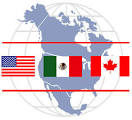
By John Dillon, KAIROS: Canadian Ecumenical Justice Initiatives
Twenty-five years ago when I first scrutinized the text of the Canada-U.S. Free Trade Agreement (FTA) I warned that the proportionality clause in the energy chapter posed a grave danger to Canadian energy sovereignty. When invoked it would require Canada to make available to U. S. importers the same proportion of our total oil or gas supply as we sold them over the previous three years. That same clause was later incorporated into NAFTA. Mexico wisely negotiated an exemption.
In 2008 I decided to test my concern that the proportionality obligation could actually lead to energy shortages in Canada. In a study entitled Over a Barrel, co- published by the CCPA and the Parkland Institute, Gordon Laxer and I explored three scenarios concerning what would happen if the clause were invoked.
Using data from Statistics Canada for the years 2004-2006, I calculated that our oil exports to the U.S. over that period were equivalent to 47.5% of total supply (defined as production plus imports). These exports were equivalent to 64.2% of Canadian oil production over that period. One scenario we explored involved what would happen if Canada decided to cut oil production by 10% for conservation purposes, as then advocated by the David Suzuki Foundation. I calculated that if the U.S. were to insist on taking 47.5% of the remaining supply, there would be an eight million barrel shortfall in oil available to meet domestic demand in 2007. This would be equivalent to four days of Canadian needs.
Each year since as new data becomes available I update the numbers first published in Over a Barrel. On the 25th anniversary of the FTA I decided to look back to what the proportionality obligation would have been in 1989, the year the FTA came into effect. I have also examined the latest data available for the years 2010-2012. The calculations reveal an unrelenting increase in the obligation to make Canadian oil available for sale to U.S. buyers year after year. I found that the proportional sharing obligation has risen from 30.8% of total supply in 1989 to 57.3% in 2013. In other words the proportionality obligation has risen by an average of 1.1 percentage points each year since the FTA came into effect.
Recalibrated in terms of Canadian oil production rather than total supply the proportional sharing obligation has risen from 38.3% in 1989 to 74.5% in 2013, an average increase of 1.5 percentage points each year.
Repeating the hypothetical scenario explored in Over a Barrel, I find that had we attempted to put aside 10% of our oil production in 2013 and had U.S. importers invoked the proportionality clause to demand 57.3% of the remaining supply, the shortfall for Canadians would have been 83 million barrels, equivalent to 48 days of domestic demand.
For natural gas the situation is somewhat different given the boom in shale gas production in the U.S. Canadian natural gas exports to the U.S. fell after 2007 while imports rose. As a result the proportional sharing obligation also fell after 2007. In 1989 the sharing obligation for gas was 32.7% of total supply. It peaked at 51.6% in 2008 before falling back to 44.7% in 2013.
But this is only part of the story. When I worked through our second scenario involving a decision to set aside 10% of Canadian gas production for use as a feedstock for the petrochemical industry, I found that the potential shortfall in 2013 was the same as it was in 2007 – equivalent to 37 days of domestic demand. The explanation appears to be that while gas exports to the US have fallen, imports of shale gas into Canada have risen even more. Meanwhile domestic production has also fallen. These changes in effect cancel each other out leaving the calculation of a potential domestic shortfall unchanged.
Given the increase in U.S. oil and gas production from the hydraulic fracturing (fracking) of tight oil and shale formations, the U.S. has reduced its dependence on petroleum imports while remaining the world’s largest net importer of oil. While the International Energy Agency projects that the U.S. will become the largest world oil producer by 2017, the IEA predicts the U.S. will remain dependent on imported oil through to 2035. There are good reasons to be sceptical that the fracking boom will continue. Geoscientist David Hughes has convinvingly documented the falling productivity of fracked wells. Moreover citizens in many states are mobilizing to prevent fracking operations from contaminating the water they drink and the air they breathe.
In the short run it appears there is little danger that the proportional sharing clause will be invoked as neither the federal government nor the producing provinces are inclined to undertake aggressive conservation measures, let alone meaningful action to halt climate change. However, in Over a Barrel we considered a third scenario – a petroleum shortage in Eastern Canada which imports two-thirds of its oil. In the event of a global supply disruption as occurred during the OPEC embargo of 1973 and in the absence of a Canadian strategic oil reserve, Canada would need to redirect Western crude from export markets to meet Eastern Canadian needs. This would no doubt cause the U.S. to invoke the proportional sharing obligation, especially if its imports from overseas were also threatened.
In the event of another global crisis the slow but steady increase in our obligation under the proportionality clause could suddenly become a grave danger to our security. The proportionality clause remains a hidden danger to Canadian energy sovereignty. Twenty-five years later the case for eliminating it is as urgent as ever.
http://www.commonfrontiers.ca/?utm_source=Common+Frontiers+general&utm_c...
John Diillon is the Ecological Economy Coordinator, for KAIROS: Canadian Ecumenical Justice Initiatives

